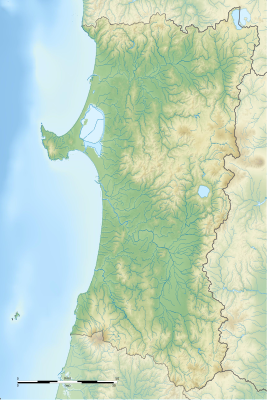Akita Castle
| Akita Castle | ||
|---|---|---|
|
reconstructed east gate of Akita Castle |
||
| Creation time : | 780 | |
| Castle type : | Hirayamajiro (hill castle) | |
| Conservation status: | Preserved (reconstruction) | |
| Place: | Akita | |
| Geographical location | 39 ° 44 ′ 25 " N , 140 ° 4 ′ 45" E | |
| Height: | 38 m TP | |
|
|
||
The castle Akita ( Jap. 秋田城 , Akita jō ) was a fortified position of the Nara period in today's Akita Prefecture , Japan . Sometimes also of Fort Akita spoken, some of the name is also synonymous with the castle Kubota used, but referred to another building in Akita.
history
During the Asuka period , Abe no Hirafu conquered the native Emishi tribe in 658 in what is now the cities of Akita and Noshiro . There he built a fort on the Mogami River . In the year 708 the country Dewa was founded from the northern half of the province Echigo and in 712 it was also raised to provincial status. However, at that time the region was still outside of effective control by the Yamato dynasty in Nara . Therefore, a number of military expeditions were sent to build settlements with armed colonists with wooden palisades in the area of Dewa, which is now the Shonai area of Yamagata Prefecture . In 733 the fort on the Mogami River was moved to the north and a new military structure, later referred to as "Akita Castle", was built on what is now the Takashimizu area of Akita. Abe no Yakamaro was sent as a shogun and Akita Castle became the base of operations to colonize the region and subdue the Emishi. In 737, Akita Castle and Taga Castle on the Pacific coast were linked by a road in a major military operation . Over the next 50 years, additional fortifications were built in Okachi in Dewa Province and in Monofu in Mutsu Province with the help of 5,000 men. This road was taken as an affront by the Emishi and after an uprising in 767 a total of 5 pacification operations were carried out in the years 776 to 811.
The castle was badly damaged in an earthquake in 830. In 878 a great rebellion, the Ganki riots , took place, which was directed against the Yamato rule and ended in the destruction of large parts of the castle. Destruction also took place in another uprising in 939, the Tenki Riots , but after each attack the damage was repaired and Akita Castle remained in active use until the Heian period .
From the 9th to the 11th centuries the castle was the residence of Dewa no suke , the vice-governor of the Dewa province . This post was later renamed Akita no suke . The castle was finally abandoned during the Zenkunen War around 1050.
today
Akita Castle was surrounded by earth walls and had gates at the main points. Archaeological excavations found foundations of military barracks as well as state buildings of the government of the Dewa province. Ceramic roof tiles, wooden counting boards and documents on lacquered paper were also discovered.
In 1939 the site was declared a Japanese Historic Site. The excavations indicate that the fortification measured about 94 meters in east-west direction and 77 meters north-south. Since then, many of the castle's structures have been reconstructed and placed in their original location.
literature
- Morton S. Schmorleitz: Castles in Japan . Charles E. Tuttle Co., Tokyo 1974, ISBN 0-8048-1102-4 , pp. 144-145.
- Hinago Motoo: Japanese Castles . Kodansha, Tokyo 1986, ISBN 0-87011-766-1 .
- Stephen Turnbull: Japanese Castles 1540-1640 . Osprey Publishing, 2003, ISBN 1-84176-429-9 .
Web links
Individual evidence
- ↑ Turnbull: Japanese Castles AD 250-1540 . P. 13
- ^ Page of the Ministry of Education

